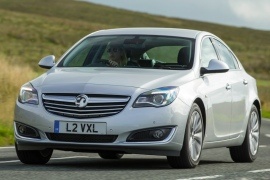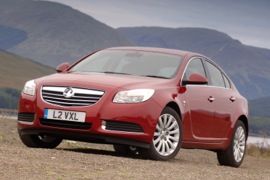VAUXHALL Insignia Hatchback Models/Series Timeline, Specifications & Photos
First production year: 2008
Engines: Gasoline, Diesel
Body style: Hatchback
After five years on the market and one big financial crisis later, Vauxhall refreshed the Insignia's lineup, and that included the Hatchback version as well.
The British automaker was not in good shape, but it still needed to upgrade its flagship model, the Insignia. While it was an excellent fleet vehicle, it was also an excellent solution for families. With the hatchback version, the car combined the advantages of a station wagon with those of a regular sedan, especially in its exterior look.
When Vauxhall upgraded the Insignia, the entire lineup got new high gloss black headlights with chromed accents, thus creating a sportier look for the vehicle. In addition, the higher trim levels got bi-xenon headlights and LED daytime running lights. On the main grille, Vauxhall included three v-shaped slats and a fourth wider one above them adorned with the brand's badge. From its profile, the Insignia featured similar rounded shapes as its non-facelifted predecessor. For the hatchback version, the automaker created a sloped-down tailgate that ended with a wide opening that cut deep into the rear bumper.
Like its siblings, the Insignia hatchback got a refreshed cabin fitted with a mixed instrument panel that sported a center TFT display in the middle flanked by analog gauges. Another improvement compared to its non-facelifted version was on the center stack, where the upper trim levels got an 8" touchscreen fitted between the vents. But the main advantage of the Insignia hatchback was its 530 liters (18.7 cu-ft) trunk, which could be extended up to 1470 liters (52 cu-ft) by folding the backseats.
Vauxhall offered the Insignia with a wide choice of turbocharged gasoline or diesel engines that were paired with either six-speed manual or automatic transmissions.
VAUXHALL Insignia Hatchback 1.4L Turbo ecoFLEX 6MT FWD (140 HP)
VAUXHALL Insignia Hatchback 1.6L Turbo ECOTEC 6AT FWD (170 HP)
VAUXHALL Insignia Hatchback 1.6L Turbo ECOTEC 6MT FWD (170 HP)
VAUXHALL Insignia Hatchback 1.8L VVT 6MT FWD (140 HP)
VAUXHALL Insignia Hatchback 2.0L Turbo ECOTEC 6AT FWD (250 HP)
VAUXHALL Insignia Hatchback 2.0L Turbo ECOTEC 6MT FWD (250 HP)
GM's European arm unveiled the Vauxhall and the Opel Insignia in October 2008 at the London Motor Show and dropped the Vectra name in the process.
Like its Vectra predecessor, the Insignia was available in three body shapes: sedan, hatchback, and station wagon. The former two were introduced at the initial event, while the latter was available from 2009.
At the front, the fresh design look and the corner-like daytime running lights placed inside the headlights created a new image for the Insignia. In its hatchback shape, it looked more like a fastback than a regular two-and-a-half vehicle. That shape helped the car achieve an excellent drag coefficient of just 0.27, which almost matched the former 1989 Vauxhall Calibra Cx of just 0.26
GM designed a completely new interior for the Insignia. It installed thicked front bucket seats with softer support for their occupants than in the Vectra. It's longer wheelbase allowed an increase for the rear passenger's legroom by 3 cm (1.2") than the outgoing Vectra. A new infotainment generation included a seven-inch color monitor with a 3-D map view, digital travel guide, and improved scroll and zoom functions. Thanks to its split-bench system, the owner could have increased the trunk size from 530 liters (18.7 cu-ft) up to 1,430 liters (50.1 cu-ft).
The carmaker installed an extensive engine range on the Insignia. Its base version featured a 1.4-liter turbocharged unit, while a 2.8-liter turbocharged V-6 powered the most potent version. The Insignia was available with either front or all-wheel-drive.

